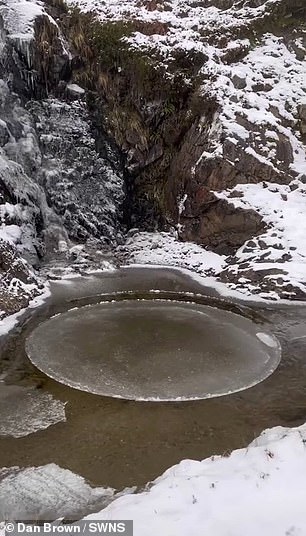Hiker captures mesmerising footage of a rare ‘ice pancake’ in the Scottish Highlands
>
Talk about an ice view! Hiker captures mesmerising footage of a rare frozen ‘pancake’ in the Scottish Highlands
A hiker captured the incredibly rare phenomenon of an ‘ice pancake’ on a mountain walk in the Scottish Highlands.
The circular sheet of ice is seen in a glen on the mountain of Beinn Bhuidhe, which is south of Lochan Shira, and north of Achadunan.
Dan Brown, 32, from Dunoon was hiking up the Munro when he came across the rare sight with his father.
He said: ‘I was hiking Beinn Bhuidhe, a Munro at the head of Loch Fyne, with my father.

A hiker captured the incredibly rare phenomenon of an ‘ice pancake’ on a mountain walk in the Scottish Highlands
‘We’d taken mountain bikes with us and, for the best part, had been carrying them up a hydro track.
‘Visibility wasn’t great, but after about an hour-and-a-half the snow stopped and cloud cover started to clear.
‘We took a break to fill our water bottles from the burn by the track – that’s when we noticed the ice disk slowly spinning at the foot of a small waterfall.’
Both Dan and his father had never seen or experienced an ice disk in the flesh and were taken aback.
He added: ‘Neither of us had ever seen anything like it, a perfect circle of ice slowly rotating in the water, so we thought it must be a rare occurrence and took some photographs and videos.
‘We assumed at the time that it was caused by the flow of the waterfall meeting the current of the burn, it wasn’t until afterwards I read about ice disks and realised this was what we’d witnessed.
‘We hadn’t encountered anyone else on the hike, it felt like we were the only people for miles around.
‘So then to happen across something so serene and perfectly formed, it felt surreal.’
Ice pancakes can range in size from 7.8 inches (20cm) to 78 inches (200cm) wide, and are ‘relatively rare’, according to the Met Office.
‘They are most frequently seen in the Baltic Sea and around Antarctica but also form relatively frequently on the Great Lakes of the United States and Canada,’ it explained.
Ice pancakes can form in one of two distinct ways, both of which require very specific conditions.
In oceans, seas and lakes, ice pancakes form when waves cause forming pieces of ice to knock against each other, rounding their edges as they freeze and grow.

Ice pancakes can range in size from 7.8 inches (20cm) to 78 inches (200cm) wide, and are ‘relatively rare’, according to the Met Office
‘Small rims are created on the edges as the knocking causes splashing water to freeze and join the rim,’ the Met Office explained.
Alternatively, ice pancakes can form when foam on a river begins to freeze.
The foam joins together, and as it is sucked into an eddy (a swirling current of water), a circular shape begins to form.
‘As other bits of frozen foam and ice hit the forming disc they freeze to it and increase its size,’ the Met Office added.
While ice pancakes often look like solid discs, they are usually quite slushy and easily break apart when lifted up.
‘However, when given the conditions to consolidate, ice pancakes can end up binding with each other to form sheet ice and in rougher conditions waves can move these sheets of ice causing them to bend and crack to create ice ridges,’ the Met Office concluded.

